Analysis of Supply Chain Challenges in Construction Industry
VerifiedAdded on 2023/03/20
|9
|2516
|53
Report
AI Summary
This report delves into the challenges the construction industry faces when adopting supply chain management (SCM) practices, often developed in the manufacturing sector. It highlights the unique nature of construction projects, the prevalence of low-bid-win tendering, and difficulties in inventory management due to the variability of each project. The report explains that the construction industry struggles to implement SCM principles because of these factors. The report then explores how the industry can overcome these difficulties by integrating SCM principles such as lean production and just-in-time methodologies, which have proven successful in the manufacturing sector. It emphasizes the importance of collaboration with suppliers, the use of third-party logistics, and the potential benefits of establishing price and equipment agreements to minimize uncertainties and improve operational efficiency. The conclusion underscores the potential for construction sub-sectors, such as house building, to benefit from SCM by standardizing products and predicting future demand.
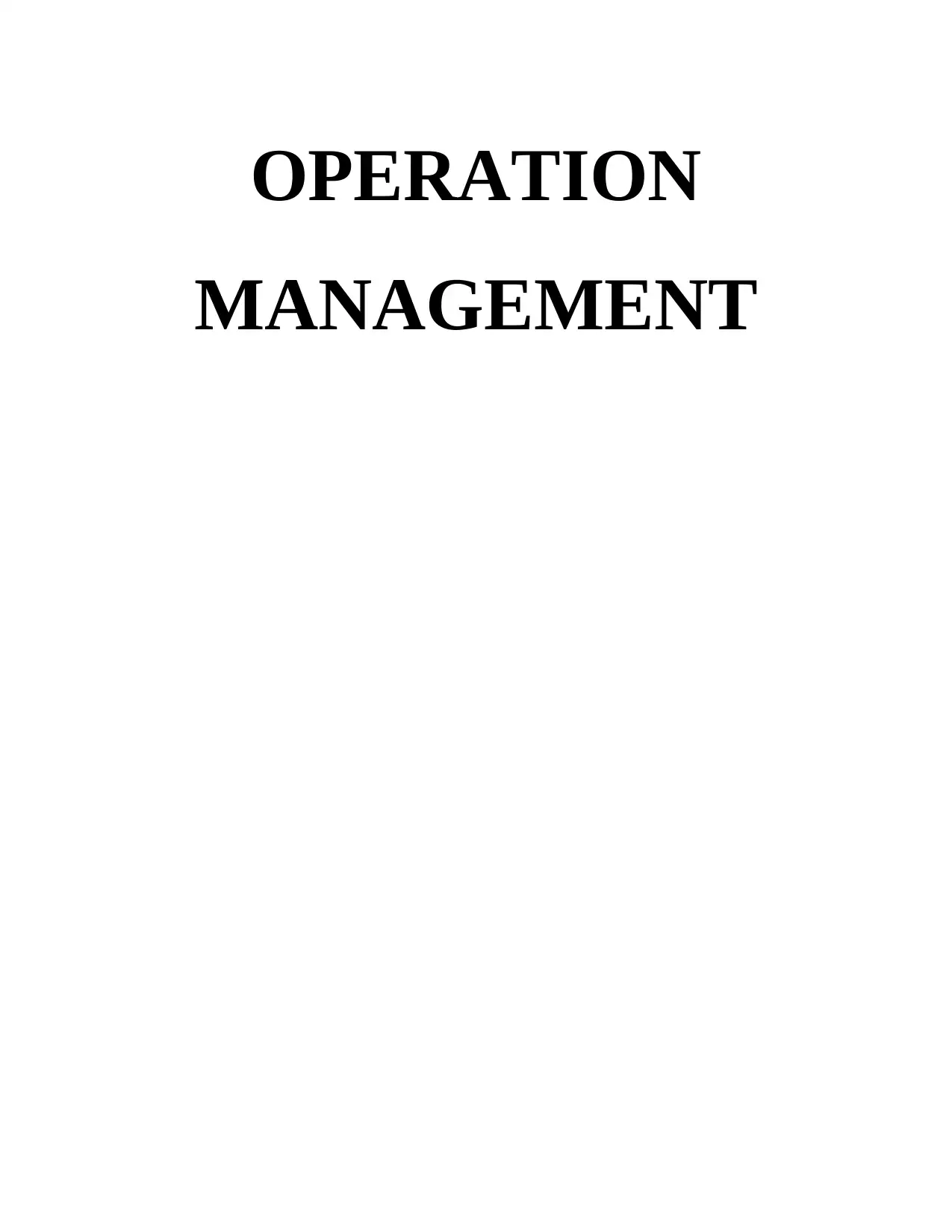
OPERATION
MANAGEMENT
MANAGEMENT
Paraphrase This Document
Need a fresh take? Get an instant paraphrase of this document with our AI Paraphraser

TABLE OF CONTENTS
INTRODUCTION...........................................................................................................................1
MAIN BODY...................................................................................................................................1
CONCLUSION ...............................................................................................................................5
REFERENCES................................................................................................................................7
INTRODUCTION...........................................................................................................................1
MAIN BODY...................................................................................................................................1
CONCLUSION ...............................................................................................................................5
REFERENCES................................................................................................................................7
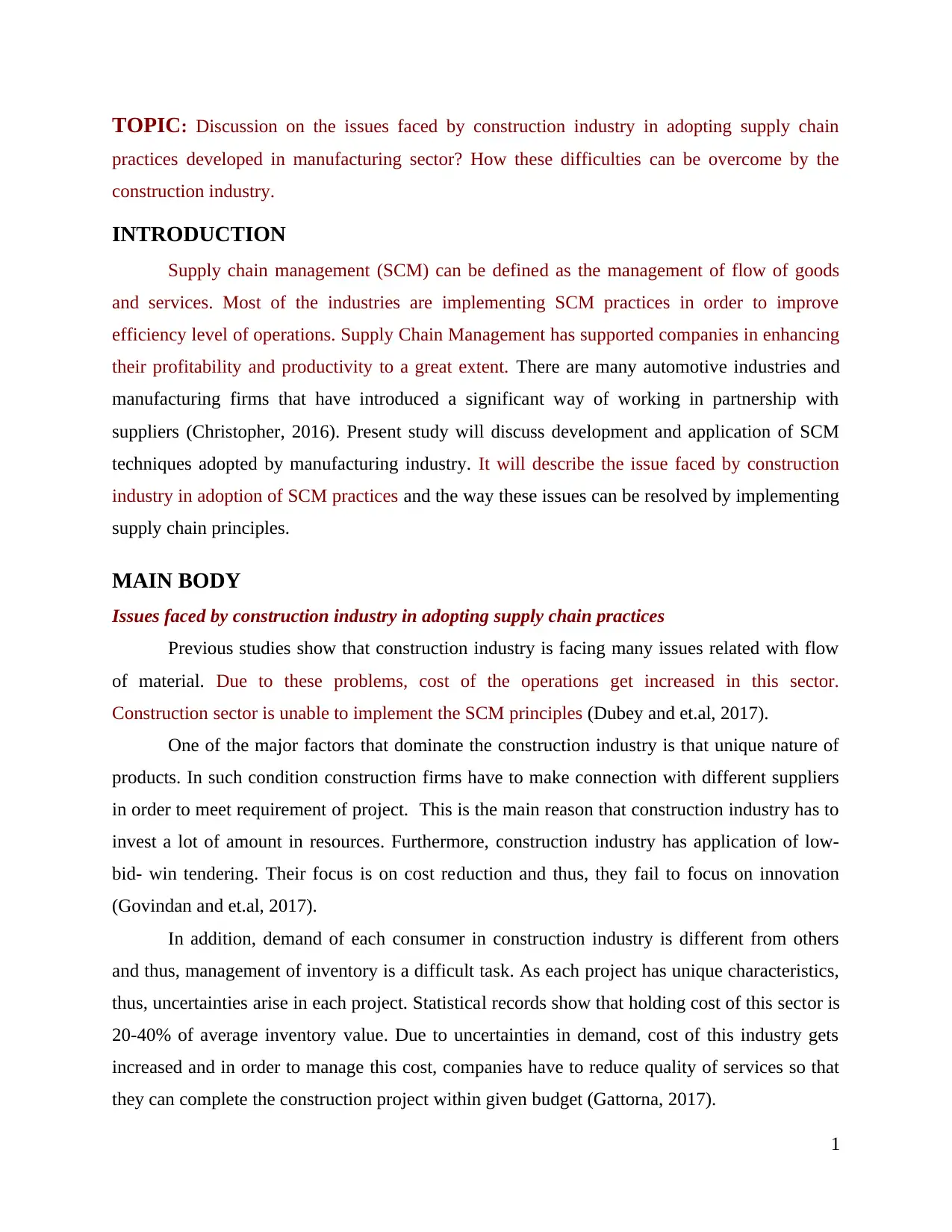
TOPIC: Discussion on the issues faced by construction industry in adopting supply chain
practices developed in manufacturing sector? How these difficulties can be overcome by the
construction industry.
INTRODUCTION
Supply chain management (SCM) can be defined as the management of flow of goods
and services. Most of the industries are implementing SCM practices in order to improve
efficiency level of operations. Supply Chain Management has supported companies in enhancing
their profitability and productivity to a great extent. There are many automotive industries and
manufacturing firms that have introduced a significant way of working in partnership with
suppliers (Christopher, 2016). Present study will discuss development and application of SCM
techniques adopted by manufacturing industry. It will describe the issue faced by construction
industry in adoption of SCM practices and the way these issues can be resolved by implementing
supply chain principles.
MAIN BODY
Issues faced by construction industry in adopting supply chain practices
Previous studies show that construction industry is facing many issues related with flow
of material. Due to these problems, cost of the operations get increased in this sector.
Construction sector is unable to implement the SCM principles (Dubey and et.al, 2017).
One of the major factors that dominate the construction industry is that unique nature of
products. In such condition construction firms have to make connection with different suppliers
in order to meet requirement of project. This is the main reason that construction industry has to
invest a lot of amount in resources. Furthermore, construction industry has application of low-
bid- win tendering. Their focus is on cost reduction and thus, they fail to focus on innovation
(Govindan and et.al, 2017).
In addition, demand of each consumer in construction industry is different from others
and thus, management of inventory is a difficult task. As each project has unique characteristics,
thus, uncertainties arise in each project. Statistical records show that holding cost of this sector is
20-40% of average inventory value. Due to uncertainties in demand, cost of this industry gets
increased and in order to manage this cost, companies have to reduce quality of services so that
they can complete the construction project within given budget (Gattorna, 2017).
1
practices developed in manufacturing sector? How these difficulties can be overcome by the
construction industry.
INTRODUCTION
Supply chain management (SCM) can be defined as the management of flow of goods
and services. Most of the industries are implementing SCM practices in order to improve
efficiency level of operations. Supply Chain Management has supported companies in enhancing
their profitability and productivity to a great extent. There are many automotive industries and
manufacturing firms that have introduced a significant way of working in partnership with
suppliers (Christopher, 2016). Present study will discuss development and application of SCM
techniques adopted by manufacturing industry. It will describe the issue faced by construction
industry in adoption of SCM practices and the way these issues can be resolved by implementing
supply chain principles.
MAIN BODY
Issues faced by construction industry in adopting supply chain practices
Previous studies show that construction industry is facing many issues related with flow
of material. Due to these problems, cost of the operations get increased in this sector.
Construction sector is unable to implement the SCM principles (Dubey and et.al, 2017).
One of the major factors that dominate the construction industry is that unique nature of
products. In such condition construction firms have to make connection with different suppliers
in order to meet requirement of project. This is the main reason that construction industry has to
invest a lot of amount in resources. Furthermore, construction industry has application of low-
bid- win tendering. Their focus is on cost reduction and thus, they fail to focus on innovation
(Govindan and et.al, 2017).
In addition, demand of each consumer in construction industry is different from others
and thus, management of inventory is a difficult task. As each project has unique characteristics,
thus, uncertainties arise in each project. Statistical records show that holding cost of this sector is
20-40% of average inventory value. Due to uncertainties in demand, cost of this industry gets
increased and in order to manage this cost, companies have to reduce quality of services so that
they can complete the construction project within given budget (Gattorna, 2017).
1
⊘ This is a preview!⊘
Do you want full access?
Subscribe today to unlock all pages.

Trusted by 1+ million students worldwide
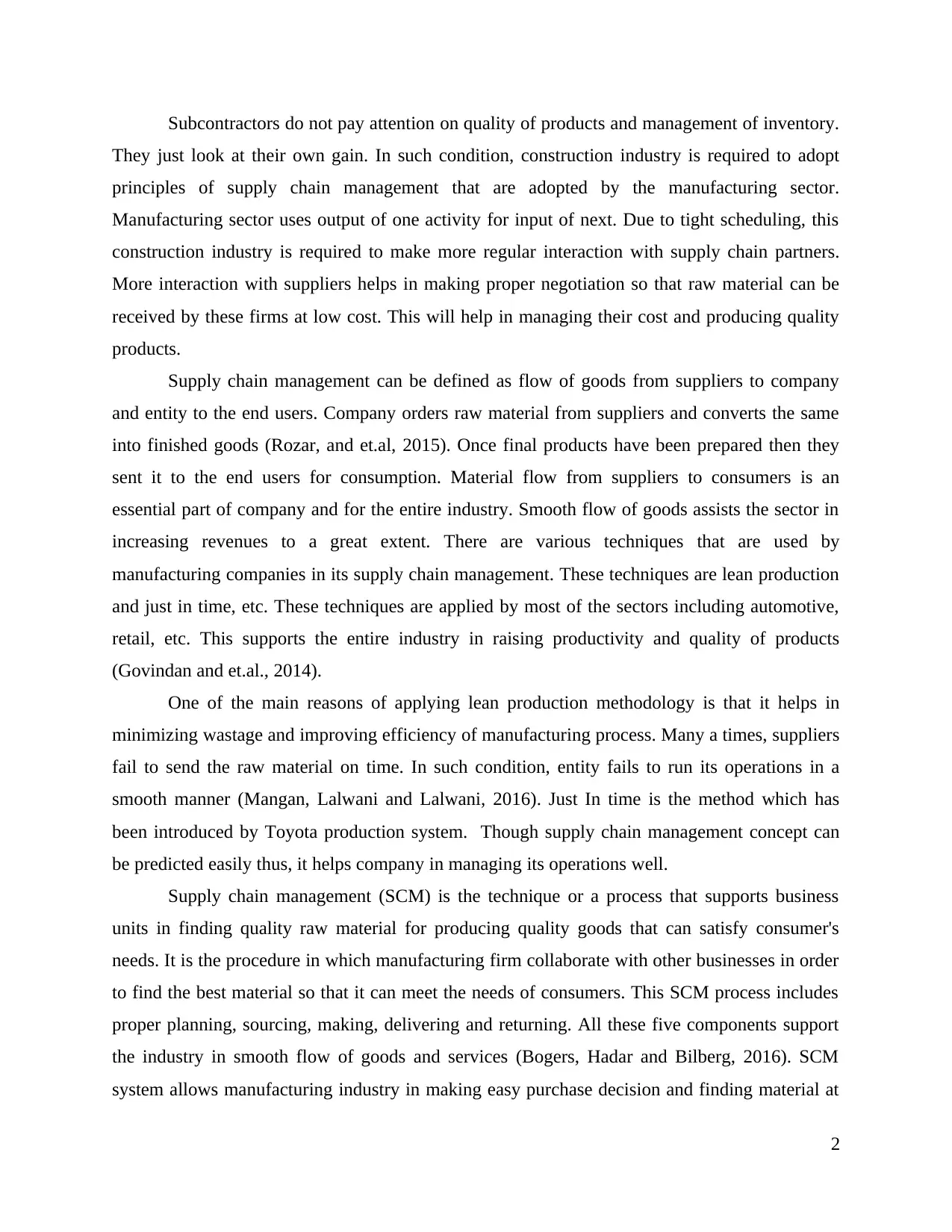
Subcontractors do not pay attention on quality of products and management of inventory.
They just look at their own gain. In such condition, construction industry is required to adopt
principles of supply chain management that are adopted by the manufacturing sector.
Manufacturing sector uses output of one activity for input of next. Due to tight scheduling, this
construction industry is required to make more regular interaction with supply chain partners.
More interaction with suppliers helps in making proper negotiation so that raw material can be
received by these firms at low cost. This will help in managing their cost and producing quality
products.
Supply chain management can be defined as flow of goods from suppliers to company
and entity to the end users. Company orders raw material from suppliers and converts the same
into finished goods (Rozar, and et.al, 2015). Once final products have been prepared then they
sent it to the end users for consumption. Material flow from suppliers to consumers is an
essential part of company and for the entire industry. Smooth flow of goods assists the sector in
increasing revenues to a great extent. There are various techniques that are used by
manufacturing companies in its supply chain management. These techniques are lean production
and just in time, etc. These techniques are applied by most of the sectors including automotive,
retail, etc. This supports the entire industry in raising productivity and quality of products
(Govindan and et.al., 2014).
One of the main reasons of applying lean production methodology is that it helps in
minimizing wastage and improving efficiency of manufacturing process. Many a times, suppliers
fail to send the raw material on time. In such condition, entity fails to run its operations in a
smooth manner (Mangan, Lalwani and Lalwani, 2016). Just In time is the method which has
been introduced by Toyota production system. Though supply chain management concept can
be predicted easily thus, it helps company in managing its operations well.
Supply chain management (SCM) is the technique or a process that supports business
units in finding quality raw material for producing quality goods that can satisfy consumer's
needs. It is the procedure in which manufacturing firm collaborate with other businesses in order
to find the best material so that it can meet the needs of consumers. This SCM process includes
proper planning, sourcing, making, delivering and returning. All these five components support
the industry in smooth flow of goods and services (Bogers, Hadar and Bilberg, 2016). SCM
system allows manufacturing industry in making easy purchase decision and finding material at
2
They just look at their own gain. In such condition, construction industry is required to adopt
principles of supply chain management that are adopted by the manufacturing sector.
Manufacturing sector uses output of one activity for input of next. Due to tight scheduling, this
construction industry is required to make more regular interaction with supply chain partners.
More interaction with suppliers helps in making proper negotiation so that raw material can be
received by these firms at low cost. This will help in managing their cost and producing quality
products.
Supply chain management can be defined as flow of goods from suppliers to company
and entity to the end users. Company orders raw material from suppliers and converts the same
into finished goods (Rozar, and et.al, 2015). Once final products have been prepared then they
sent it to the end users for consumption. Material flow from suppliers to consumers is an
essential part of company and for the entire industry. Smooth flow of goods assists the sector in
increasing revenues to a great extent. There are various techniques that are used by
manufacturing companies in its supply chain management. These techniques are lean production
and just in time, etc. These techniques are applied by most of the sectors including automotive,
retail, etc. This supports the entire industry in raising productivity and quality of products
(Govindan and et.al., 2014).
One of the main reasons of applying lean production methodology is that it helps in
minimizing wastage and improving efficiency of manufacturing process. Many a times, suppliers
fail to send the raw material on time. In such condition, entity fails to run its operations in a
smooth manner (Mangan, Lalwani and Lalwani, 2016). Just In time is the method which has
been introduced by Toyota production system. Though supply chain management concept can
be predicted easily thus, it helps company in managing its operations well.
Supply chain management (SCM) is the technique or a process that supports business
units in finding quality raw material for producing quality goods that can satisfy consumer's
needs. It is the procedure in which manufacturing firm collaborate with other businesses in order
to find the best material so that it can meet the needs of consumers. This SCM process includes
proper planning, sourcing, making, delivering and returning. All these five components support
the industry in smooth flow of goods and services (Bogers, Hadar and Bilberg, 2016). SCM
system allows manufacturing industry in making easy purchase decision and finding material at
2
Paraphrase This Document
Need a fresh take? Get an instant paraphrase of this document with our AI Paraphraser
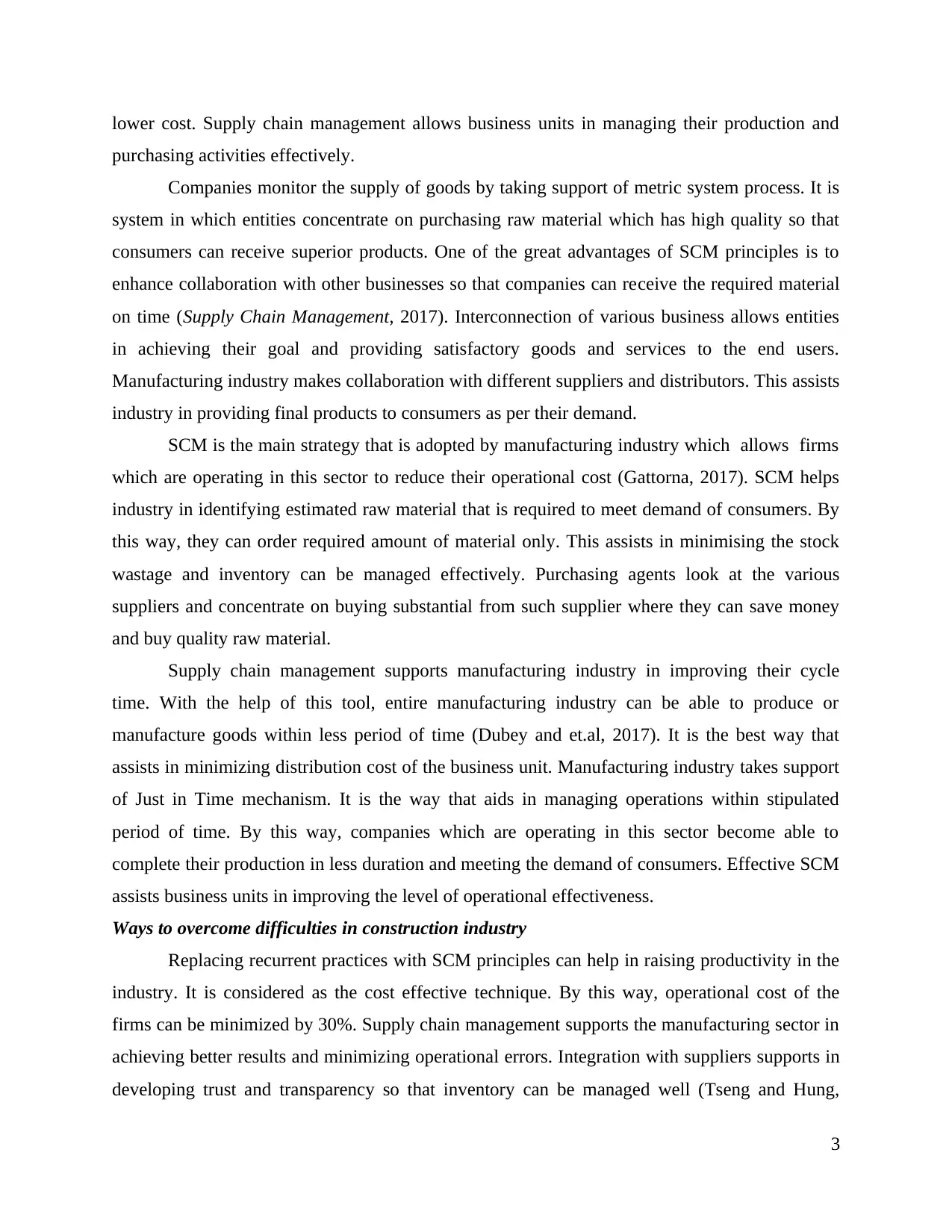
lower cost. Supply chain management allows business units in managing their production and
purchasing activities effectively.
Companies monitor the supply of goods by taking support of metric system process. It is
system in which entities concentrate on purchasing raw material which has high quality so that
consumers can receive superior products. One of the great advantages of SCM principles is to
enhance collaboration with other businesses so that companies can receive the required material
on time (Supply Chain Management, 2017). Interconnection of various business allows entities
in achieving their goal and providing satisfactory goods and services to the end users.
Manufacturing industry makes collaboration with different suppliers and distributors. This assists
industry in providing final products to consumers as per their demand.
SCM is the main strategy that is adopted by manufacturing industry which allows firms
which are operating in this sector to reduce their operational cost (Gattorna, 2017). SCM helps
industry in identifying estimated raw material that is required to meet demand of consumers. By
this way, they can order required amount of material only. This assists in minimising the stock
wastage and inventory can be managed effectively. Purchasing agents look at the various
suppliers and concentrate on buying substantial from such supplier where they can save money
and buy quality raw material.
Supply chain management supports manufacturing industry in improving their cycle
time. With the help of this tool, entire manufacturing industry can be able to produce or
manufacture goods within less period of time (Dubey and et.al, 2017). It is the best way that
assists in minimizing distribution cost of the business unit. Manufacturing industry takes support
of Just in Time mechanism. It is the way that aids in managing operations within stipulated
period of time. By this way, companies which are operating in this sector become able to
complete their production in less duration and meeting the demand of consumers. Effective SCM
assists business units in improving the level of operational effectiveness.
Ways to overcome difficulties in construction industry
Replacing recurrent practices with SCM principles can help in raising productivity in the
industry. It is considered as the cost effective technique. By this way, operational cost of the
firms can be minimized by 30%. Supply chain management supports the manufacturing sector in
achieving better results and minimizing operational errors. Integration with suppliers supports in
developing trust and transparency so that inventory can be managed well (Tseng and Hung,
3
purchasing activities effectively.
Companies monitor the supply of goods by taking support of metric system process. It is
system in which entities concentrate on purchasing raw material which has high quality so that
consumers can receive superior products. One of the great advantages of SCM principles is to
enhance collaboration with other businesses so that companies can receive the required material
on time (Supply Chain Management, 2017). Interconnection of various business allows entities
in achieving their goal and providing satisfactory goods and services to the end users.
Manufacturing industry makes collaboration with different suppliers and distributors. This assists
industry in providing final products to consumers as per their demand.
SCM is the main strategy that is adopted by manufacturing industry which allows firms
which are operating in this sector to reduce their operational cost (Gattorna, 2017). SCM helps
industry in identifying estimated raw material that is required to meet demand of consumers. By
this way, they can order required amount of material only. This assists in minimising the stock
wastage and inventory can be managed effectively. Purchasing agents look at the various
suppliers and concentrate on buying substantial from such supplier where they can save money
and buy quality raw material.
Supply chain management supports manufacturing industry in improving their cycle
time. With the help of this tool, entire manufacturing industry can be able to produce or
manufacture goods within less period of time (Dubey and et.al, 2017). It is the best way that
assists in minimizing distribution cost of the business unit. Manufacturing industry takes support
of Just in Time mechanism. It is the way that aids in managing operations within stipulated
period of time. By this way, companies which are operating in this sector become able to
complete their production in less duration and meeting the demand of consumers. Effective SCM
assists business units in improving the level of operational effectiveness.
Ways to overcome difficulties in construction industry
Replacing recurrent practices with SCM principles can help in raising productivity in the
industry. It is considered as the cost effective technique. By this way, operational cost of the
firms can be minimized by 30%. Supply chain management supports the manufacturing sector in
achieving better results and minimizing operational errors. Integration with suppliers supports in
developing trust and transparency so that inventory can be managed well (Tseng and Hung,
3
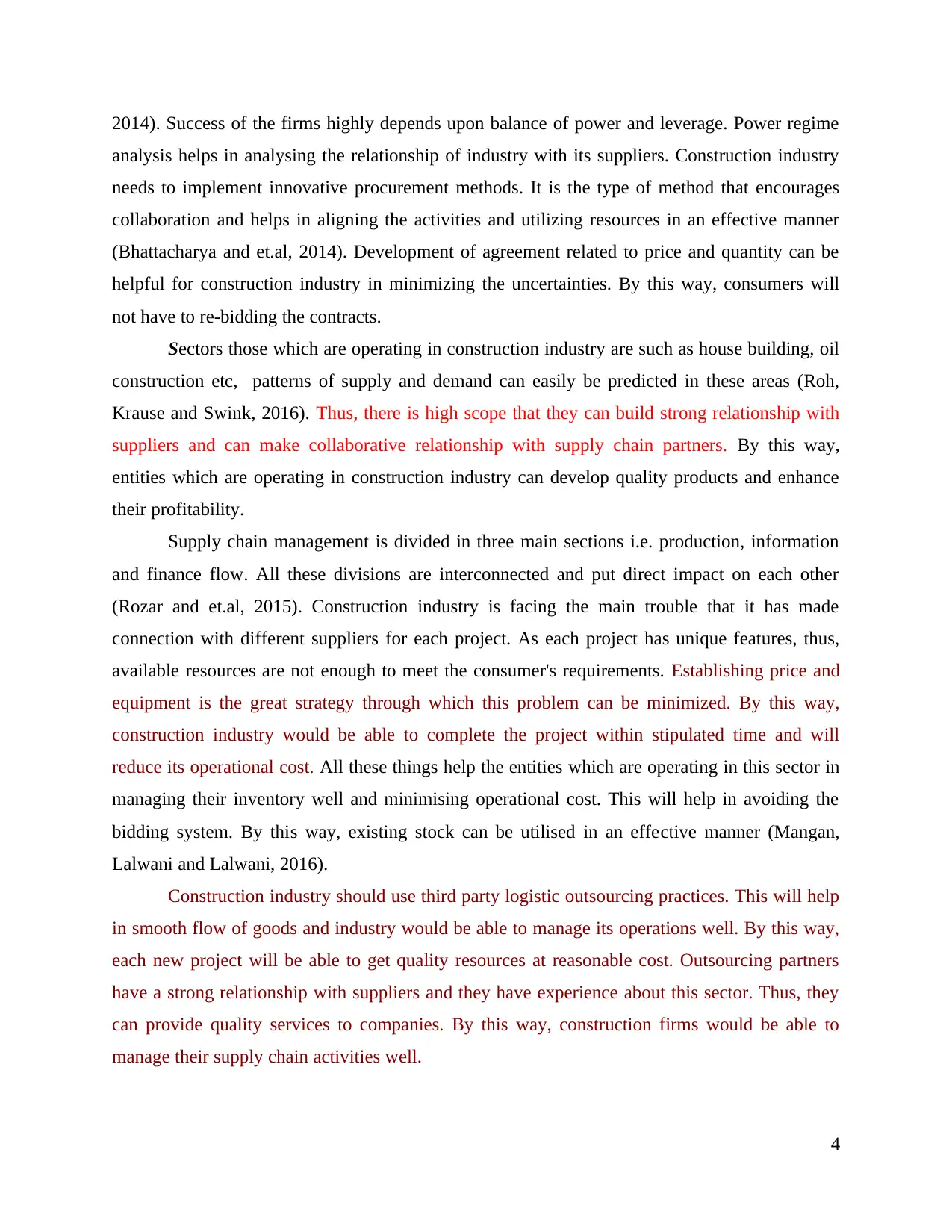
2014). Success of the firms highly depends upon balance of power and leverage. Power regime
analysis helps in analysing the relationship of industry with its suppliers. Construction industry
needs to implement innovative procurement methods. It is the type of method that encourages
collaboration and helps in aligning the activities and utilizing resources in an effective manner
(Bhattacharya and et.al, 2014). Development of agreement related to price and quantity can be
helpful for construction industry in minimizing the uncertainties. By this way, consumers will
not have to re-bidding the contracts.
Sectors those which are operating in construction industry are such as house building, oil
construction etc, patterns of supply and demand can easily be predicted in these areas (Roh,
Krause and Swink, 2016). Thus, there is high scope that they can build strong relationship with
suppliers and can make collaborative relationship with supply chain partners. By this way,
entities which are operating in construction industry can develop quality products and enhance
their profitability.
Supply chain management is divided in three main sections i.e. production, information
and finance flow. All these divisions are interconnected and put direct impact on each other
(Rozar and et.al, 2015). Construction industry is facing the main trouble that it has made
connection with different suppliers for each project. As each project has unique features, thus,
available resources are not enough to meet the consumer's requirements. Establishing price and
equipment is the great strategy through which this problem can be minimized. By this way,
construction industry would be able to complete the project within stipulated time and will
reduce its operational cost. All these things help the entities which are operating in this sector in
managing their inventory well and minimising operational cost. This will help in avoiding the
bidding system. By this way, existing stock can be utilised in an effective manner (Mangan,
Lalwani and Lalwani, 2016).
Construction industry should use third party logistic outsourcing practices. This will help
in smooth flow of goods and industry would be able to manage its operations well. By this way,
each new project will be able to get quality resources at reasonable cost. Outsourcing partners
have a strong relationship with suppliers and they have experience about this sector. Thus, they
can provide quality services to companies. By this way, construction firms would be able to
manage their supply chain activities well.
4
analysis helps in analysing the relationship of industry with its suppliers. Construction industry
needs to implement innovative procurement methods. It is the type of method that encourages
collaboration and helps in aligning the activities and utilizing resources in an effective manner
(Bhattacharya and et.al, 2014). Development of agreement related to price and quantity can be
helpful for construction industry in minimizing the uncertainties. By this way, consumers will
not have to re-bidding the contracts.
Sectors those which are operating in construction industry are such as house building, oil
construction etc, patterns of supply and demand can easily be predicted in these areas (Roh,
Krause and Swink, 2016). Thus, there is high scope that they can build strong relationship with
suppliers and can make collaborative relationship with supply chain partners. By this way,
entities which are operating in construction industry can develop quality products and enhance
their profitability.
Supply chain management is divided in three main sections i.e. production, information
and finance flow. All these divisions are interconnected and put direct impact on each other
(Rozar and et.al, 2015). Construction industry is facing the main trouble that it has made
connection with different suppliers for each project. As each project has unique features, thus,
available resources are not enough to meet the consumer's requirements. Establishing price and
equipment is the great strategy through which this problem can be minimized. By this way,
construction industry would be able to complete the project within stipulated time and will
reduce its operational cost. All these things help the entities which are operating in this sector in
managing their inventory well and minimising operational cost. This will help in avoiding the
bidding system. By this way, existing stock can be utilised in an effective manner (Mangan,
Lalwani and Lalwani, 2016).
Construction industry should use third party logistic outsourcing practices. This will help
in smooth flow of goods and industry would be able to manage its operations well. By this way,
each new project will be able to get quality resources at reasonable cost. Outsourcing partners
have a strong relationship with suppliers and they have experience about this sector. Thus, they
can provide quality services to companies. By this way, construction firms would be able to
manage their supply chain activities well.
4
⊘ This is a preview!⊘
Do you want full access?
Subscribe today to unlock all pages.

Trusted by 1+ million students worldwide
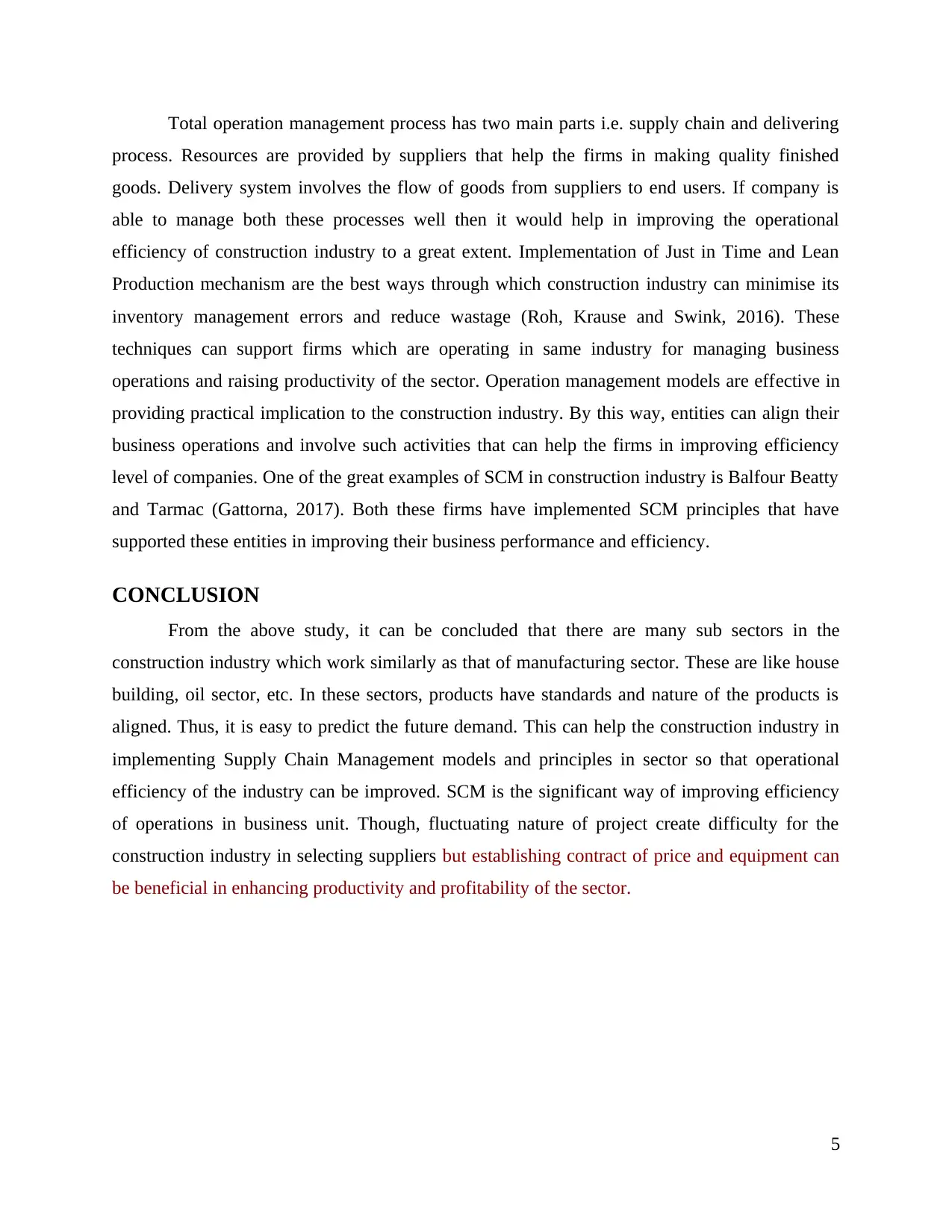
Total operation management process has two main parts i.e. supply chain and delivering
process. Resources are provided by suppliers that help the firms in making quality finished
goods. Delivery system involves the flow of goods from suppliers to end users. If company is
able to manage both these processes well then it would help in improving the operational
efficiency of construction industry to a great extent. Implementation of Just in Time and Lean
Production mechanism are the best ways through which construction industry can minimise its
inventory management errors and reduce wastage (Roh, Krause and Swink, 2016). These
techniques can support firms which are operating in same industry for managing business
operations and raising productivity of the sector. Operation management models are effective in
providing practical implication to the construction industry. By this way, entities can align their
business operations and involve such activities that can help the firms in improving efficiency
level of companies. One of the great examples of SCM in construction industry is Balfour Beatty
and Tarmac (Gattorna, 2017). Both these firms have implemented SCM principles that have
supported these entities in improving their business performance and efficiency.
CONCLUSION
From the above study, it can be concluded that there are many sub sectors in the
construction industry which work similarly as that of manufacturing sector. These are like house
building, oil sector, etc. In these sectors, products have standards and nature of the products is
aligned. Thus, it is easy to predict the future demand. This can help the construction industry in
implementing Supply Chain Management models and principles in sector so that operational
efficiency of the industry can be improved. SCM is the significant way of improving efficiency
of operations in business unit. Though, fluctuating nature of project create difficulty for the
construction industry in selecting suppliers but establishing contract of price and equipment can
be beneficial in enhancing productivity and profitability of the sector.
5
process. Resources are provided by suppliers that help the firms in making quality finished
goods. Delivery system involves the flow of goods from suppliers to end users. If company is
able to manage both these processes well then it would help in improving the operational
efficiency of construction industry to a great extent. Implementation of Just in Time and Lean
Production mechanism are the best ways through which construction industry can minimise its
inventory management errors and reduce wastage (Roh, Krause and Swink, 2016). These
techniques can support firms which are operating in same industry for managing business
operations and raising productivity of the sector. Operation management models are effective in
providing practical implication to the construction industry. By this way, entities can align their
business operations and involve such activities that can help the firms in improving efficiency
level of companies. One of the great examples of SCM in construction industry is Balfour Beatty
and Tarmac (Gattorna, 2017). Both these firms have implemented SCM principles that have
supported these entities in improving their business performance and efficiency.
CONCLUSION
From the above study, it can be concluded that there are many sub sectors in the
construction industry which work similarly as that of manufacturing sector. These are like house
building, oil sector, etc. In these sectors, products have standards and nature of the products is
aligned. Thus, it is easy to predict the future demand. This can help the construction industry in
implementing Supply Chain Management models and principles in sector so that operational
efficiency of the industry can be improved. SCM is the significant way of improving efficiency
of operations in business unit. Though, fluctuating nature of project create difficulty for the
construction industry in selecting suppliers but establishing contract of price and equipment can
be beneficial in enhancing productivity and profitability of the sector.
5
Paraphrase This Document
Need a fresh take? Get an instant paraphrase of this document with our AI Paraphraser
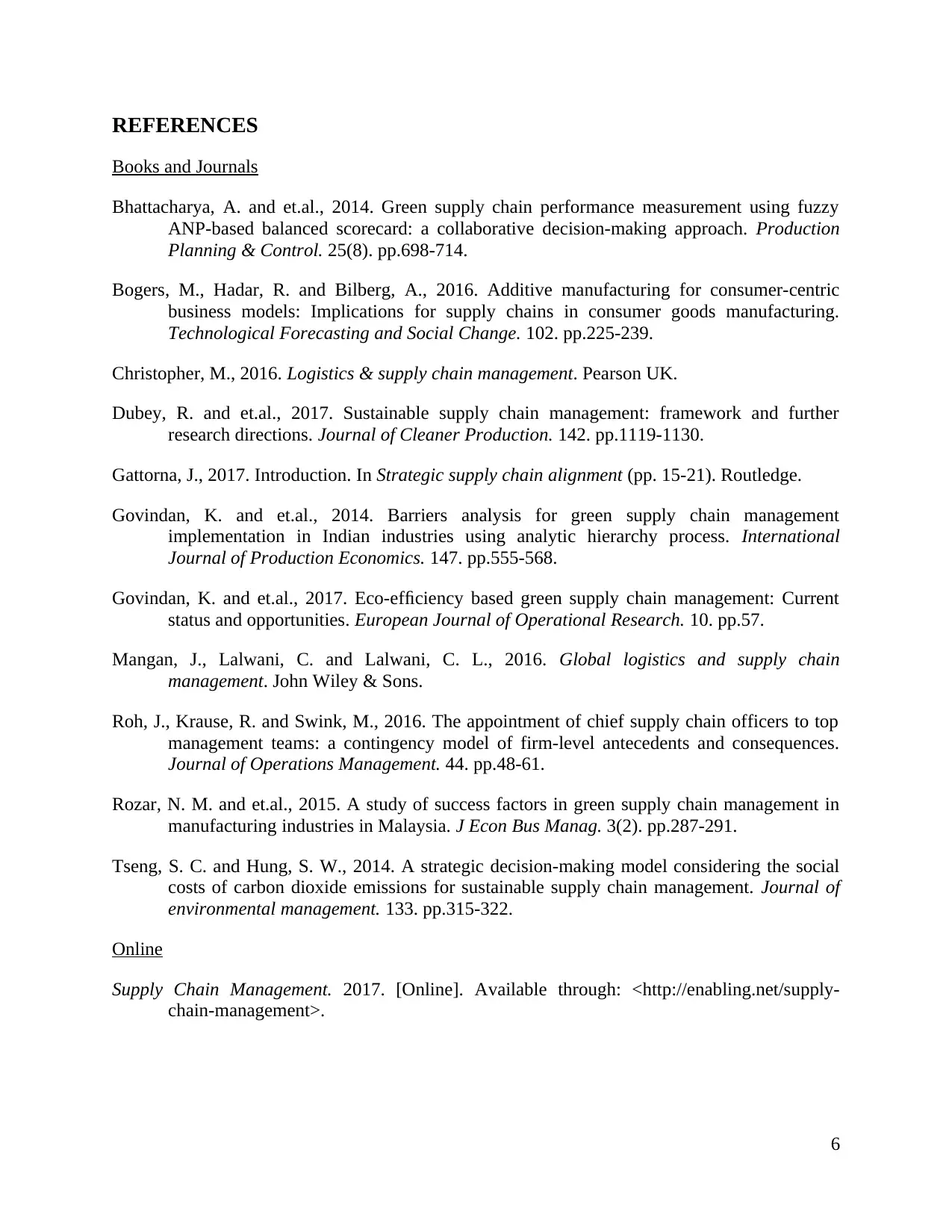
REFERENCES
Books and Journals
Bhattacharya, A. and et.al., 2014. Green supply chain performance measurement using fuzzy
ANP-based balanced scorecard: a collaborative decision-making approach. Production
Planning & Control. 25(8). pp.698-714.
Bogers, M., Hadar, R. and Bilberg, A., 2016. Additive manufacturing for consumer-centric
business models: Implications for supply chains in consumer goods manufacturing.
Technological Forecasting and Social Change. 102. pp.225-239.
Christopher, M., 2016. Logistics & supply chain management. Pearson UK.
Dubey, R. and et.al., 2017. Sustainable supply chain management: framework and further
research directions. Journal of Cleaner Production. 142. pp.1119-1130.
Gattorna, J., 2017. Introduction. In Strategic supply chain alignment (pp. 15-21). Routledge.
Govindan, K. and et.al., 2014. Barriers analysis for green supply chain management
implementation in Indian industries using analytic hierarchy process. International
Journal of Production Economics. 147. pp.555-568.
Govindan, K. and et.al., 2017. Eco-efficiency based green supply chain management: Current
status and opportunities. European Journal of Operational Research. 10. pp.57.
Mangan, J., Lalwani, C. and Lalwani, C. L., 2016. Global logistics and supply chain
management. John Wiley & Sons.
Roh, J., Krause, R. and Swink, M., 2016. The appointment of chief supply chain officers to top
management teams: a contingency model of firm-level antecedents and consequences.
Journal of Operations Management. 44. pp.48-61.
Rozar, N. M. and et.al., 2015. A study of success factors in green supply chain management in
manufacturing industries in Malaysia. J Econ Bus Manag. 3(2). pp.287-291.
Tseng, S. C. and Hung, S. W., 2014. A strategic decision-making model considering the social
costs of carbon dioxide emissions for sustainable supply chain management. Journal of
environmental management. 133. pp.315-322.
Online
Supply Chain Management. 2017. [Online]. Available through: <http://enabling.net/supply-
chain-management>.
6
Books and Journals
Bhattacharya, A. and et.al., 2014. Green supply chain performance measurement using fuzzy
ANP-based balanced scorecard: a collaborative decision-making approach. Production
Planning & Control. 25(8). pp.698-714.
Bogers, M., Hadar, R. and Bilberg, A., 2016. Additive manufacturing for consumer-centric
business models: Implications for supply chains in consumer goods manufacturing.
Technological Forecasting and Social Change. 102. pp.225-239.
Christopher, M., 2016. Logistics & supply chain management. Pearson UK.
Dubey, R. and et.al., 2017. Sustainable supply chain management: framework and further
research directions. Journal of Cleaner Production. 142. pp.1119-1130.
Gattorna, J., 2017. Introduction. In Strategic supply chain alignment (pp. 15-21). Routledge.
Govindan, K. and et.al., 2014. Barriers analysis for green supply chain management
implementation in Indian industries using analytic hierarchy process. International
Journal of Production Economics. 147. pp.555-568.
Govindan, K. and et.al., 2017. Eco-efficiency based green supply chain management: Current
status and opportunities. European Journal of Operational Research. 10. pp.57.
Mangan, J., Lalwani, C. and Lalwani, C. L., 2016. Global logistics and supply chain
management. John Wiley & Sons.
Roh, J., Krause, R. and Swink, M., 2016. The appointment of chief supply chain officers to top
management teams: a contingency model of firm-level antecedents and consequences.
Journal of Operations Management. 44. pp.48-61.
Rozar, N. M. and et.al., 2015. A study of success factors in green supply chain management in
manufacturing industries in Malaysia. J Econ Bus Manag. 3(2). pp.287-291.
Tseng, S. C. and Hung, S. W., 2014. A strategic decision-making model considering the social
costs of carbon dioxide emissions for sustainable supply chain management. Journal of
environmental management. 133. pp.315-322.
Online
Supply Chain Management. 2017. [Online]. Available through: <http://enabling.net/supply-
chain-management>.
6

7
⊘ This is a preview!⊘
Do you want full access?
Subscribe today to unlock all pages.

Trusted by 1+ million students worldwide
1 out of 9
Related Documents
Your All-in-One AI-Powered Toolkit for Academic Success.
+13062052269
info@desklib.com
Available 24*7 on WhatsApp / Email
![[object Object]](/_next/static/media/star-bottom.7253800d.svg)
Unlock your academic potential
Copyright © 2020–2025 A2Z Services. All Rights Reserved. Developed and managed by ZUCOL.





